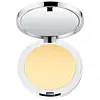What's inside
What's inside
 Key Ingredients
Key Ingredients

 Benefits
Benefits

 Concerns
Concerns

 Ingredients Side-by-side
Ingredients Side-by-side

Mica
Cosmetic ColorantDimethicone
EmollientPolyethylene
AbrasiveZinc Stearate
Cosmetic ColorantMagnesium Myristate
Silica
AbrasiveBoron Nitride
AbsorbentSqualane
EmollientOryza Sativa Seed Protein
AntioxidantDimethicone/Vinyl Dimethicone Crosspolymer
Skin ConditioningNylon-12
Lauroyl Lysine
Skin ConditioningMethylparaben
PreservativeSodium Dehydroacetate
PreservativePropylparaben
PreservativeSilica Silylate
EmollientMica
Cosmetic ColorantZinc Stearate
Cosmetic ColorantSilica
AbrasiveOctyldodecyl Stearoyl Stearate
EmollientMagnesium Myristate
Lauroyl Lysine
Skin ConditioningCitrus Grandis Peel Extract
AstringentPoria Cocos Sclerotium Extract
AstringentMagnolia Grandiflora Bark Extract
AntimicrobialAstrocaryum Murumuru Seed Butter
EmollientLactobacillus Ferment
Skin ConditioningCaffeine
Skin ConditioningBentonite
AbsorbentPolyethylene
AbrasiveHdi/Trimethylol Hexyllactone Crosspolymer
Lecithin
EmollientCaprylyl Glycol
EmollientSqualane
EmollientTocopheryl Acetate
AntioxidantHydroxyapatite
AbrasiveChlorphenesin
AntimicrobialWater
Skin ConditioningSodium Dehydroacetate
PreservativeCI 77891
Cosmetic ColorantIron Oxides
CI 19140
Cosmetic ColorantMica, Zinc Stearate, Silica, Octyldodecyl Stearoyl Stearate, Magnesium Myristate, Lauroyl Lysine, Citrus Grandis Peel Extract, Poria Cocos Sclerotium Extract, Magnolia Grandiflora Bark Extract, Astrocaryum Murumuru Seed Butter, Lactobacillus Ferment, Caffeine, Bentonite, Polyethylene, Hdi/Trimethylol Hexyllactone Crosspolymer, Lecithin, Caprylyl Glycol, Squalane, Tocopheryl Acetate, Hydroxyapatite, Chlorphenesin, Water, Sodium Dehydroacetate, CI 77891, Iron Oxides, CI 19140
Ingredients Explained
These ingredients are found in both products.
Ingredients higher up in an ingredient list are typically present in a larger amount.
This ingredient comes from a fatty acid (lauric acid) and amino acid (lysine). It is used to add a silky feel to cosmetics.
According to a manufacturer, its fatty acid base leaves a silky feeling on the skin. It also has emollient properties because of this. Emollients help soften skin by preventing water from evaporating.
Lauroyl lysine is barely soluble in water.
Learn more about Lauroyl LysineWe don't have a description for Magnesium Myristate yet.
Mica is a naturally occurring mineral used to add shimmer and color in cosmetics. It can also help improve the texture of a product or give it an opaque, white/silver color.
Serecite is the name for very fine but ragged grains of mica.
This ingredient is often coated with metal oxides like titanium dioxide. Trace amounts of heavy metals may be found in mica, but these metals are not harmful in our personal products.
Mica has been used since prehistoric times throughout the world. Ancient Egyptian, Indian, Greek, Roman, Aztec, and Chinese civilizations have used mica.
Learn more about MicaPolyethylene is a synthetic ingredient that helps the skin retain moisture. It is a polymer.
It is also typically used within product formulations to help bind solid ingredients together and thicken oil-based ingredients. When added to balms and emulsions, it helps increase the melting point temperature.
Silica, also known as silicon dioxide, is a naturally occurring mineral. It is used as a fine, spherical, and porous powder in cosmetics.
Though it has exfoliant properties, the function of silica varies depending on the product.
The unique structure of silica enhances the spreadability and adds smoothness, making it a great texture enhancer.
It is also used as an active carrier, emulsifier, and mattifier due to its ability to absorb excess oil.
In some products, tiny microneedles called spicules are made from silica or hydrolyzed sponge. When you rub them in, they lightly polish away dead skin layers and enhance the penetration of active ingredients.
Learn more about SilicaThis ingredient is a preservative with antimicrobial properties. It is the sodium salt of dehydroacetic acid.
It is especially effective at preventing bacterial and fungal growth in low concentrations.
Squalane is an emollient that helps the skin hold onto moisture. It's an oily liquid that occurs naturally in certain types of fish and plant oils.
Because squalane boosts hydration in the skin, it also comes with plenty of benefits: it is an antioxidant and can help fight free radicals and skin damage. Squalane is also found to have a detoxifying effect when applied.
Squalane comes from squalene, which occurs naturally within the sebum of our skin. It is one of the oils our skin produces to keep itself hydrated. Squalane is the hydrogenated version of squalene and has a longer shelf life.
Research shows that squalane is non-irritating (even at 100% concentration).
In general, it's a fantastic ingredient. It does a great job at hydrating the skin, and it's suitable for those with sensitive skin.
The source of squalane may impact malassezia / fungal acne. This is because olive oil derived squalane can contain impurities such as fatty acids and plant waxes. Sugarcane derived squalane is recommended for anyone with malassezia concerns.
Is squalane vegan?
This depends on the source. Squalane can be derived from both plants and animals. Most squalane used in skincare comes from plants.
Please note: the source of squalane is only known if disclosed by the brand. We recommend reaching out to the brand if you have any questions about their squalane.
Read more about squalene with an "e".
Is squalane an oil?
Squalane is often called an oil, but it’s technically not; it’s a hydrocarbon, meaning it’s only made of carbon and hydrogen, unlike true oils which are triglycerides made of fatty acids and glycerol.
The term “oil-free” isn’t regulated, so companies can define it however they want. Some exclude all oils, while others just avoid mineral oil or comedogenic oils.
While some people avoid oils thinking they cause breakouts, the right kind of oil (or oil-like ingredient like squalane) can actually help balance and hydrate your skin. It’s worth testing out simple oils or squalane to see what works best for your skin.
Learn more about SqualaneZinc Stearate is the metal salt of stearic acid. It is a white solid used to bind, thicken, and lubricate products.
This ingredient is common in powder makeup, where it helps keep the powder together.
Zinc Stearate is hydrophobic and repels water.
This ingredient can be sourced from non-animal or animal sources. It is best to reach out to the brand to see where they source this ingredient from.
Learn more about Zinc Stearate